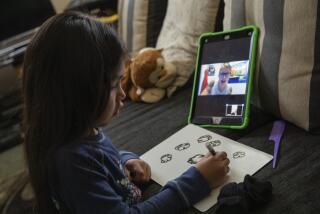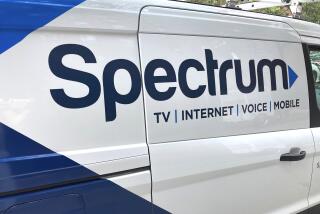Its Speed Is Seductive, but DSL Technology Is Far From Glitch-Free
It doesn’t take long to fall in love with digital subscriber line, the high-speed Internet access technology that works over traditional copper phone lines.
The attraction is obvious: It’s the speed. DSL service offers computer users always-on Internet cruising speeds that blaze up to 140 times faster than that offered by 56K modems sold today with personal computers.
For many users, that kind of speed will outweigh the more frustrating aspects of DSL service, which for me included lengthy delays and confusion during installation, as well as inexplicable technical glitches.
Phone and cable companies, aware of the public’s craving for faster Internet access, are scrambling to provide it. Many DSL providers have eliminated their hefty installation and equipment fees and slashed their monthly service charges to new lows.
Despite the hype surrounding DSL, the technology is relatively new, and it has drawbacks and reliability issues that consumers must consider before signing up.
The technology, for example, falls well short of the dependability consumers expect from their phone service.
If you want your always-on Internet connection to be truly always on, then you’ll need to find a carrier who will provide you with some kind of service guarantee, but you’ll pay extra for it.
In the residential Internet-surfing world, speed is generally measured in kilobits per second. A dial-up 56K modem can transmit data at peak speeds of 56 kilobits per second. The highest level of DSL, by comparison, transmits at speeds up to 8,000 kilobits per second.
It may be tempting to buy the fastest service available, but it’s a good idea to match your DSL service speed with your intended use. If you love videoconferencing, you’ll need higher speed than for standard Internet cruising.
With DSL, the installation process can be a chore, and the monthlong wait for service is bound to get longer as cut-rate deals lure a crush of new customers.
Limited Availability
DSL’s biggest limitation, however, is that not everyone can get it. The service is available only in places where the phone company has “conditioned” the copper lines.
In addition, DSL is distance-sensitive, which means that transmission speeds and general quality of service drop steadily the farther the signals must travel between the customer’s site and the nearest phone company switching station.
DSL’s distance and speed limitations vary depending on the type of DSL service offered. The one most commonly available to residential users is ADSL, or asymmetric digital subscriber line, which means the top speeds differ for inbound and outbound data.
ADSL service generally can’t function beyond about 18,000 feet from a phone switch--a distance equal to about 3.4 miles.
My home, it turns out, is about 17,500 feet from the nearest switching station, too close to the boundary to get good ADSL service. The best service I can get is IDSL, or ISDN digital subscriber line, which provides peak speeds almost three times faster than a 56K modem.
In a trial arranged by trade organization DSL Forum, I tried the IDSL service from Concentric Network Corp., the San Jose-based Internet service provider. Concentric acted as my ISP, biller and point of contact for installation. The company contracts with Covad Communications for the copper line, the use of which Covad leases from my local phone company, Pacific Bell.
This three-company setup makes for a bit more hassle during installation, because both Covad and PacBell had to trek to my house for separate appointments.
Concentric set up mid-July installation dates, one for PacBell to provide a DSL-ready copper line, and a separate two-hour appointment with a Covad technician to install a DSL “modem” and set up my phone wiring and computer to handle DSL.
Before Covad arrived, I purchased a network interface card, or NIC (in this case, a plug-and-play ethernet 10Base-T/100Base-T LAN card by D-Link for about $30), which you need to make it all work.
The companies I dealt with will not do this part for you because they want to avoid liability issues inherent in opening your computer. I’m a novice, but I had no trouble installing the chip set and associated software in my desktop.
The Covad technician showed me the all-important row of green lights on my router, explaining that five of the six will be solid (not blinking) when all is well with my DSL. But all was not well: Covad discovered problems with the PacBell copper line.
PacBell took two weeks to solve the problem, so my DSL was officially “in service” Aug. 4. I enjoyed several weeks of high-speed bliss, and then I got the urge to buy a new computer. My PC was ancient in computer terms (1996), and after talking to Concentric, I figured it would be easy to switch the DSL to a new computer. Wrong.
My new computer was a dream, but after reloading software and switching my ethernet card, there were problems galore. The DSL refused to work, I got odd Windows 98 errors and my laser printer stopped working.
Covad agreed to come out, then didn’t show. After some confusion, a Covad technician arrived two days later and found that the line and the router were both fine. The computer store reloaded Windows, etc., and suggested that my ethernet card might have been damaged in the switch.
I bought a new one (this time a $32 Linksys card, a brand recommended by the Covad technician), and the installation went smoothly. My DSL was running again by late August.
Connection Frustration
During my testing over the last five months, there were times when the DSL connection appeared to be completely lost--flashing green lights or showing no green lights at all.
I discovered, for example, that my DSL line doesn’t work when I use a dial-up connection to my office at the same time--even though the DSL phone line is separate from the phone line I use for dial-up services.
This could be a Internet browser issue or signal interference--known as “cross talk”--from my other phone line. Still, it’s a sampling of the kinds of problems that can crop up unexpectedly.
The upshot: DSL is great, even fabulous at the low-end speeds that I could get.
But installation is frustrating, and the connection is not as reliable as standard phone service, especially when you’re near the distance cutoff point for DSL.
To Concentric’s credit, they were polite and apologetic about my DSL glitches and kept me updated on the installation through e-mail.
My installation fees were waived as part of the trial, but subscribers who signed up when I did last year would have paid Concentric more than $1,000 in one-time costs, including a Covad installation fee of $325, a Concentric fee of $200, inside wiring charges of $90 per hour, and the purchase of the FlowPoint router for $399. I bought the ethernet card on my own for about $30.
The Concentric service I got--TeleSpeed Remote 144--is primarily a small-business offering, but it’s the only Concentric package offered for the lowly speed available at my house.
The cost is $124 per month, and it includes unlimited Internet access, eight static Internet addresses, five e-mail accounts and other goodies.
Concentric’s current promotions waive installation charges, and the price of the router is reduced to $149 or is free, depending on the service plan. The company primarily focuses on the business market, but does sell a HomeOffice ADSL service for $69 a month, or $89 a month for a faster connection.
PacBell’s basic DSL service currently sells for about $40 per month, with installation and equipment charges waived in return for a one-year contract. Other competitors have been dropping their DSL prices, too, so it pays to shop around.
Times staff writer Elizabeth Douglass can be reached at [email protected].
(BEGIN TEXT OF INFOBOX / INFOGRAPHIC)
Decoding DSL
Digital subscriber line technology, the high-speed Internet access service that works over regular phone lines, is not a one-size-fits-all proposition. DSL technology comes in several “flavors,” each with its own characteristics and speed capabilities. Here are some common Internet tasks and their corresponding bandwidth requirements:
*--*
Application bandwidth/speed Minimum Voice calls over the Internet 56 kilobits per second Interactive video games 128 kbps Web surfing 128 kbps Tele-working 144 kbps Desktop videoconferencing 384 kbps Distance learning 384 kbps Web hosting 384 kbps to 6 megabits per second Video on demand 1.5 mbps
*--*
Sources: DSL for Dummies, IDG Books Worldwide
(BEGIN TEXT OF INFOBOX / INFOGRAPHIC)
Online Resources
These Internet sites can help demystify DSL technology and show users how to get it. Some sites even help measure the distance between your home or office and the closest phone switch--a calculation that will tell you if you are within reach of DSL and, if so, at what speeds.
*--*
Site Who runs it https://www.2wire.com 2Wire Inc. https://www.xdsl.com TeleChoice Inc. https://www.dsllife.com DSL Forum https://www.aspergantis.com/adsl/information.htm Aspergantis https://www.dsl.com DSL.com Inc.
*--*
Sources: Times research






